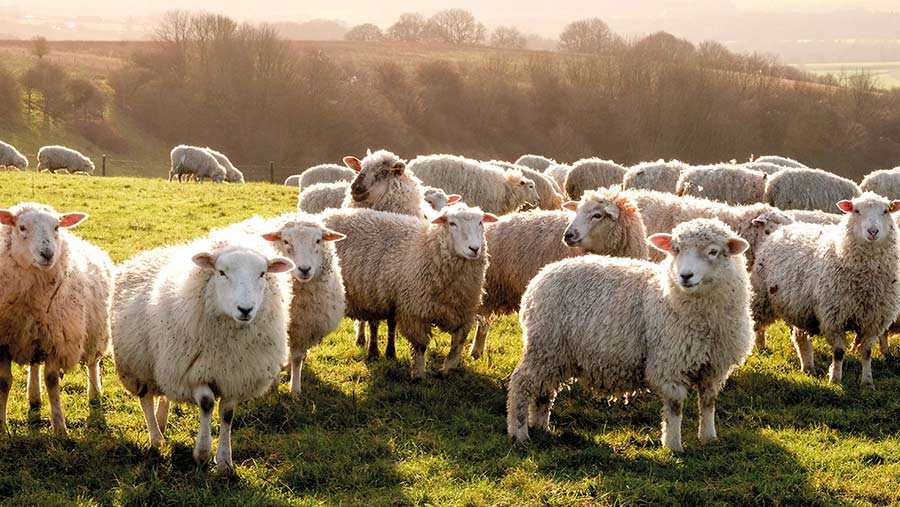How will red meat markets fare during the rest of 2022?
 © Gill/AdobeStock
© Gill/AdobeStock Beef, lamb, and pork farmgate prices have mainly stayed above last year’s levels in 2022 and are all higher than this time last year.
Despite elevated farmgate prices, spiralling on-farm input costs across all sectors are putting significant pressure on margins.
Export volumes of beef, lamb and pork increased by 17% (45,000t) during the first half of 2022 to total 314,000t.
See also: June census shows pig numbers struggling while OSR up
Continued export and retail demand will be crucial in supporting farmgate prices for the remainder of the year.
Beef
Deadweight steer prices were up 25.5p/kg on the same week last year on 3 September, and the all-prime average has risen by 25p/kg since the beginning of 2022.
At GB auction markets, steers averaged 242.8p/kg, while heifers averaged 252.9p/kg for the week ending 6 September.
Prices have been driven by tight supply both in the UK and on the Continent so far this year.
However, cattle throughput is typically slightly higher towards the end of the year due to Christmas demand and producers managing stock levels heading into winter, according to the AHDB.
Scott Ferrie, senior auctioneer at Darlington Auction Mart, said beef had been having a good trade recently and prices should remain stable for the rest of the year.
Mr Ferrie suggested many businesses didn’t have the number of cattle they normally would on farm, so supply would stay tight and demand would continue.
“All fat cattle are in demand at the moment, especially handy weight butchers’ cattle, which have been very much in demand,” said Mr Ferrie.
Top-end cuts are harder to sell, but retail sales should benefit from children going back to school and more in-home cooking taking place, he added.
Livestock marketing group Meadow Quality said abattoirs had been reporting better retail sales than expected, in part due to the rising cost of living encouraging consumers to eat in more often.
However, there are still too many factors to consider in the beef market to be able to determine where prices will be for winter fattening cattle, according to the livestock group.
Sheep
Deadweight lamb prices peaked in mid-June at 692.9p/kg and have since dropped by 158.3p/kg to total 534.3p/kg for the week ending 3 September.
Liveweight lamb prices fell 2.1p/kg to 234.5p/kg for the week ending 6 September.
Lamb is currently at its highest production levels for the year to date, and is likely to begin a seasonal decline in throughput, which will tighten supply.
During the second half of 2022, the AHDB estimates that lamb throughput will be 2% higher year-on-year.
Rizvan Khalid, managing director at Shropshire-based exporter Euro Quality Lambs, said there was caution among UK consumers, but inflation was lower in France and Germany, and there was still demand to send exports there.
Sterling has also fallen against the euro and stood at £1:€1.16 on 6 September, which is good for export trade.
“Production has generally been higher than last year, but it has pulled back a little bit recently as the price has dropped,” he said.
“There’s a bit less New Zealand lamb in the UK and there is not a lot of other lamb products around, so the main risk is whether people switch to cheaper proteins. The price gap has closed slightly between lamb and other proteins, so this may help to offset this.”
Mr Khalid said the food-service sector had noticed fewer people eating out and retail sales were likely to benefit from this.
“You would expect lamb prices to be better from mid-October onwards as demand for lamb picks up into the winter,” he said.
Pork
The EU-spec standard pig price (SPP) averaged 199.5p/kg for the week ending 3 September, up 1.1p/kg on the previous week.
Despite prices now being more than 43p/kg above the same week last year and up 59p/kg since the start of the year, pig producers are still making significant losses.
Cost of production during August was estimated at 223p/kg deadweight, according to the AHDB.
Producers were estimated to be making a loss of £52/head during the second quarter of 2022.
The AHDB has predicted a 6% contraction in the breeding herd during 2022, with much of this drop-off taking place towards the end of the year.
Despite this decrease in production and tightening supply for the sector, it is likely to have little effect on prices due to the volume of pigmeat imports, according to pig consultant Peter Crichton.
“Foreign imports are coming over and foreign pig prices are equivalent to 170p/kg, which the UK is unable to compete with on a price level,” he said.
“Although there is a shortage of pigs coming up, it only makes a big difference if we see imports go down at the same time, and we also see the foreign price come up.”
